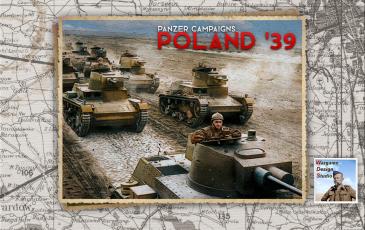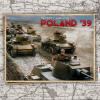0918_01b_Wilno - Either AI - PzC 31 Poland '39

b59375da7db50f7a9280.jpg) 0 - 0 - 0
0 - 0 - 0
4f09d1569063283d124d.jpg)
| Rating: | 0 (0) |
| Games Played: | 0 |
| SM: | 1 |
| Turns: | 12 |
| Type: | Stock |
| First Side: | Axis (Poland-39) |
| Second Side: | Allies (Poland-39) |
Date: September 18th, 1939 - Size: Small - Location: Wilno
Intended for play as Human vs Either AI or Head to Head
Scenario Briefing: Scenario Briefing: After a hasty and poorly organized mobilization, the Red Army entered Poland on September 17th, 1939 in accordance with the secret protocol of the Molotov-Ribbentrop Pact. Having deployed nearly all of its army to the west to oppose the German invasion, Poland had few forces available in the east to resist the 900,000-man Soviet invasion force. The KOP border guards, often unsure of whether the the Soviets were friend or foe, were overrun on September 17th while regional military commanders scrambled to improvise some defense of the major cities and supply depots in the east. In Wilno, Colonel Jaroslaw Okulicz-Kozaryn mustered ten battalions - four from the reserve centers of the 1st Legions Infantry Division and Wilno Cavalry Brigade, three battalions of KOP border guards withdrawn from the Lithuanian border, the local guard battalion, and two improvised battalions formed from miscellaneous military personnel and university students.
Wilno was a principal objective of the Byelorussian Front and Komadarm Mikhail Kovalev assigned most of the mechanized elements of the Polotsk and Minsk groups (later the 3rd and 11th armies) to its capture. Advancing ahead of the main body, 36th Cavalry Division's two tank regiments arrived near the southern outskirts of the city around 17:00 on September 18th. Though the Wilno garrison was numerically strong, it was desperately short on heavy weapons and had little with which to counter an armored attack. Believing the defense of Wilno to be pointless, Okulicz-Kozaryn decided to abandon the city to the Soviets and march his forces into neutral Lithuania to be interned. He sent his second-in-command, Tadeusz Podwysocki, under a flag of truce to inform the Soviets that he did not intend to defend the city, but Podwysocki was shot at and the message was never delivered. When he returned, Podwysocki found that Okulicz-Kozaryn had left Wilno with a portion of the garrison. Assuming command of what remained, he decided to fight rather than follow his commander to Lithuania. Soon, however, given the weight of Soviet numbers and the Poles' lack of anti-tank weapons, Podwysocki to would recognize the futility of further resistance. Rather than a determined defense to the last, the Battle of Wilno would be little more than a confused and chaotic rearguard action.
Design Notes:
1. In this hypothetical version of the scenario, there is lower percentage for Polish withdrawal. Polish units will likely be withdrawn more gradually.
Recommended Rules: (Default)
Alternative Assault Resolution, Artillery Set Up, Recon Spotting, Virtual Supply Trucks, Optional Surrender, Low Visibility Air Effects, Quality Fatigue Modifier, Counter Battery Fire, Night Fatigue, Programmed Weather.
Additionally, Delayed Disruption Reporting will provide a more challenging experience for the attacking player.
Intended for play as Human vs Either AI or Head to Head
Scenario Briefing: Scenario Briefing: After a hasty and poorly organized mobilization, the Red Army entered Poland on September 17th, 1939 in accordance with the secret protocol of the Molotov-Ribbentrop Pact. Having deployed nearly all of its army to the west to oppose the German invasion, Poland had few forces available in the east to resist the 900,000-man Soviet invasion force. The KOP border guards, often unsure of whether the the Soviets were friend or foe, were overrun on September 17th while regional military commanders scrambled to improvise some defense of the major cities and supply depots in the east. In Wilno, Colonel Jaroslaw Okulicz-Kozaryn mustered ten battalions - four from the reserve centers of the 1st Legions Infantry Division and Wilno Cavalry Brigade, three battalions of KOP border guards withdrawn from the Lithuanian border, the local guard battalion, and two improvised battalions formed from miscellaneous military personnel and university students.
Wilno was a principal objective of the Byelorussian Front and Komadarm Mikhail Kovalev assigned most of the mechanized elements of the Polotsk and Minsk groups (later the 3rd and 11th armies) to its capture. Advancing ahead of the main body, 36th Cavalry Division's two tank regiments arrived near the southern outskirts of the city around 17:00 on September 18th. Though the Wilno garrison was numerically strong, it was desperately short on heavy weapons and had little with which to counter an armored attack. Believing the defense of Wilno to be pointless, Okulicz-Kozaryn decided to abandon the city to the Soviets and march his forces into neutral Lithuania to be interned. He sent his second-in-command, Tadeusz Podwysocki, under a flag of truce to inform the Soviets that he did not intend to defend the city, but Podwysocki was shot at and the message was never delivered. When he returned, Podwysocki found that Okulicz-Kozaryn had left Wilno with a portion of the garrison. Assuming command of what remained, he decided to fight rather than follow his commander to Lithuania. Soon, however, given the weight of Soviet numbers and the Poles' lack of anti-tank weapons, Podwysocki to would recognize the futility of further resistance. Rather than a determined defense to the last, the Battle of Wilno would be little more than a confused and chaotic rearguard action.
Design Notes:
1. In this hypothetical version of the scenario, there is lower percentage for Polish withdrawal. Polish units will likely be withdrawn more gradually.
Recommended Rules: (Default)
Alternative Assault Resolution, Artillery Set Up, Recon Spotting, Virtual Supply Trucks, Optional Surrender, Low Visibility Air Effects, Quality Fatigue Modifier, Counter Battery Fire, Night Fatigue, Programmed Weather.
Additionally, Delayed Disruption Reporting will provide a more challenging experience for the attacking player.





















